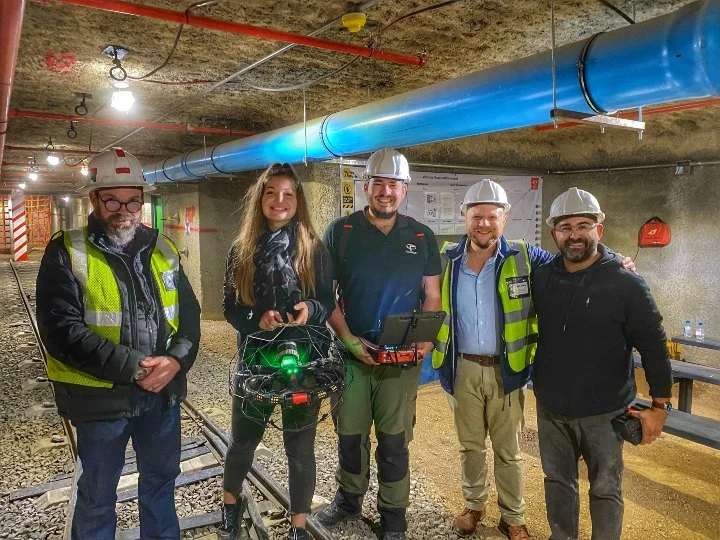- Case Studies >
- Indoor Drone in Underground Mining: Accessing the...
Indoor Drone in Underground Mining: Accessing the Inaccessible
Flyability’s collision tolerant Elios drone has performed multiple missions in the North American Palladium (NAP) Lac des Iles mine near Thunder Bay, Ontario.
Benefits In A Nutshell
|
Time In contrast to a full day, Elios performs the mission in 1 hour. |
Costs “The Elios allows planning and significantly better decision-making, how do you put a price on that?” |
Safety Allows to remove the human element in a hostile and dangerous environment. |
Using Drones Where There Is No Gps, No Light, And Humans Can’t Go
Flyability’s collision tolerant Elios drone has performed multiple missions in the North American Palladium (NAP) Lac des Iles mine near Thunder Bay, Ontario.
Palladium is a precious metal critical to automobile manufacturing, and NAP is one of only two pure palladium producers in the world. With both an open pit and underground mine, their extensive operation requires frequent visual inspections to monitor ground conditions and ensure both the safety and productivity of their workers.
[Related read: Mining Tools—A Complete Guide to Mining Industry Equipment]
The expert team at Unmanned Aerial Services Inc. (UAS Inc.) were asked to perform drone inspections in NAP’s most challenging environments. Matt MacKinnon and Jason Carignan, UAS Inc. founders, are drone and mining professionals who use Flyability’s Elios drone to perform difficult underground inspections in GPS and light -denied areas with little or no accessibility.
Customer Need: Information From Inaccessible Spaces
Underground mines can be dangerous places, especially after excavation. One need for more information, is in the open cavern resulting from the mining and excavation, called an open stope. Once all the recoverable ore has been extracted from the stope, the removed material must be replaced – a process known as “backfilling” – in order to prevent caving in the surrounding area and ensure the safety and continuity in the mine. The areas, which can be unstable, are completely inaccessible by law to employees because of their extreme danger. Before the introduction of the Elios drone, the only tools available to assess conditions before backfilling was a Cavity Monitoring Survey (CMS) on a cart or boom arm: ineffective at getting through the tall piles of muck on the floor, or in going around corner, or seeing beyond a deep brow. The other method used for accessing a large stope area is a borehole camera which can be lowered into the stope through an existing drill hole: which can also be ineffective at completely inspecting the area due to being limited to the actual location of the hole and where it exits into the stope from above.
Determining the condition of the area is critical to the efficient mine planning and continued development of the mine. “Ground conditions in a mine are very important,” says Jason Carignan. “The ground can actually start to give way if there is nothing around it to support it.” Without sufficient data to determine how large the space currently is, it is difficult for mines to determine how much backfill material is required to fill the void and ensure the surrounding ground is stable.

Backfilling is both time consuming and expensive. “In the past, it was a guessing game even at the most modern mines,” says Matt MacKinnon. “A very, very expensive guessing game.” That lack of information ultimately resulted in the mines backfilling the areas by simply guessing at the amount of material required.
Another need for inspection arises when the company needs to evaluate the height and condition of a stope ceiling (known as the back.) Normally performed by a CMS laser on a cable – an imperfect or sometimes unavailable solution, depending upon the conditions of the stope – experts need to know what the back of the stope looks like after blasting in order to prevent future problems on other levels of the mine, which could potentially threaten lives and production.

The Elios Solution
The team at UAS Inc. flew Flyability’s Elios drone in both cases, providing the company with information previously unavailable to them. Standing safely under supported ground, well outside of the restricted areas, the team was able to operate the drone to gather information about the ground conditions, geological features, and dikes (fault lines) that may indicate where walls are likely to fall.
Again, standing safely under supported ground, well away from the restricted area, the team flew the Elios against the back of the stope despite the presence of explosives, and were able to accurately evaluate the height and condition. Using this data, the company can use AutoCad to create a rough model of the stope, used to evaluate risks and plan work.
Results: A Fraction Of The Cost
In contrast to the full day – or longer, depending upon the availability of equipment – that it would normally take to evaluate a stope for backfilling, the Elios was able to perform the mission in an onsite visit of 1 hour, a time difference that results in the Elios inspection being “a fraction of the cost,” says Jason.
But the real savings don’t come from just the time spent on the inspection. The otherwise unavailable data that the Elios provides allows planning and significantly better decision-making tools. “How do you put a price on that?” says Matt. “You’re in the hundreds of thousands, or even millions… you can spend millions to access an area only to find that it’s beyond rehabilitation.
Conclusion
Mining is a critical industry, but it can be a dangerous one. Because of the environment, ground-based robots can’t always provide a solution. Flyability’s Elios drone allows data gathering and inspections in places unsafe for humans, and provides the mining industry with tools to maintain safety, reduce waste, and increase production.


.jpg)
.png)

















